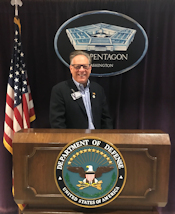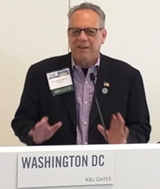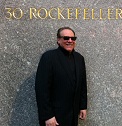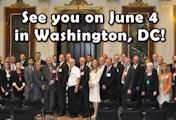Summary of NNI at Ten: Nanotechnology Innovation Summit – Part 2
Posted on December 21st, 2010 | No Comments »
This is a continuation of the program summary from Friday, December 10th at the Nanotechnology Innovation Summit http://www.nsti.org/events/NNI/
The keynote session featured two distinguished speakers, Representative Bart Gordon and Ambassador Richard Russell. Representative Gordon, as most of you know, has been a tireless advocate for in Congress for science, technology, and STEM education generally, and for the NNI in particular. He reminded us that the House of Representatives has passed the NNI Amendments Act twice – as a standalone bill and as part of the America COMPETES Act – but that so far the Senate has failed to follow suit on either lead. Rep. Gordon does feel there is still an outside chance for action this year, with his fellow Tennessean Senator Lamar Alexander championing the effort. Ambassador Russell, formerly Deputy Director of Technology at OSTP and now CEO of VIAforward, reminded us how unusual it is to have a coordinated multiagency initiative, with a growing budget across three administrations and substantial achievements toward stated goals. He attributed the success of the NNI to three factors: nanotechnology is relevant, receives bipartisan support, and has been championed in both the legislative and administrative branches. In reviewing the historical NNI budgets overall and by agency, Ambassador Russell pointed out that EHS research, NIH funding, and DOE funding have grown particularly rapidly.
Three more high-ranking Agency officials addressed Friday’s audience: Dr. Francis Collins, Director of the National Institutes of Health; Dr. Patrick Gallagher, Director of the National Institute of Standards and Technology; and Dr. Subra Suresh, Director of the National Science Foundation. Dr. Collins began his remarks with a return to the topic of international competitiveness, noting that a recent comment in Nature (Follow the money, Wang and Shapira) ranked NIH a gratifying fifth among all nanotechnology research funders internationally – four places behind the National Natural Science Foundation of China. Dr. Collins went on to describe discovery, diagnostic, and therapeutic nanotechnology research sponsored by the various Institutes which make up NIH. While the National Cancer Institute provides about 40% of the NIH total nanotech funding, he also reminded us of the significant research efforts at several other Institutes including the National Institute of Biomedical Imaging and Bioengineering, the National Institute of General Medical Sciences, the National Center for Research Resources, the National Heart Lung and Blood Institute, and his own previous home, the National Human Genome Research Institute. One of the newer therapeutic approaches he discussed was the use of nanoparticles to deliver siRNA, which has proved difficult to administer using conventional methods. Dr. Collins gave an example of new approaches the Institutes are taking to support researchers. By limiting eligibility for the Director’s New Innovator Awards to researchers who have not previously been NIH Principal Investigators, and through an application and review process that emphasizes creativity over detailed budgeting, NIH is trying to make it easier for young researchers to establish independent careers. Fifty-two researchers were funded in the first year of the New Innovator program. Eight of them – 15% of all those selected through a very competitive process – are working in nanotechnology.
Dr. Gallagher gave a very comprehensive presentation of NIST’s role in supporting technology development and advanced manufacturing. NIST’s participation in the NNI covers a range of activities within the agency’s broad mission, such as providing researchers (many of them from industry) access to state-of-the-art nanofabrication and characterization tools, producing standard reference materials, advancing and disseminating nanoscale measurement tools and techniques, and generating data and procedures to support the work of voluntary consensus standards groups. Dr. Gallagher noted that many of these can be loosely categorized as R&D infrastructure, for which he offered the definition “an underlying set of capabilities enabling research to move into practice.” One thing that kind of infrastructure does – with NIST’s EHS-related work being the big example in nano – is allow us to get risk management right. He also touted the Technology Innovation Program’s (TIP) extensive funding for nanomanufacturing R&D and for work on advanced nanomaterials. Dr. Gallagher’s talk was perhaps more focused on the second word in the Summit’s title – Innovation – than any other speaker’s. He singled out the Nanoelectronics Research Initiative as a spectacularly successful example of public-private partnership in innovation. He calculates the NRI leveraging of public funds to date as 73:1, and noted that the initiative, while maintaining its precompetitive nature, is moving on to a new phase. In the NRI’s first five years, a thousand ideas flowered. Now they are starting to select the most promising of those ideas for further development. Finally, he pointed out that three of the four goals in the NNI Strategic plan are squarely in the infrastructure space he described. While these goals are unchanged from 2004 and 2007 Plans, the draft 2010 Plan couples them more deeply into program planning, including calls for deeper international engagement and a full life cycle approach to EHS issues and responsible development. This should improve the community’s ability to manage and compensate risk and allow us to move forward in areas like sustainability and environmental stewardship, which Dr. Gallagher believes to be fundamental strengths of nanotechnology.
Dr. Suresh, who was confirmed as NSF Director less than two months ago, used the “Nano2” report we recently pointed our readers to as the basis for his presentation. If you haven’t read Nanotechnology Research Directions for Societal Needs in 2020 yet, I suggest you download a copy from the web. Dr. Suresh comes to NSF from MIT, where he led a group researching the mechanical properties of both biological and man-made materials at the nanoscale. He sprinkled insights from his own research throughout his talk. For example he said that the ability to pull individual molecules with calibrated force is now routinely available in commercial instruments. Among the key Nano2 findings Dr. Suresh presented are these:
– The U.S. Federal investment exceeds $12B
– There are >50 nanotechnology-based drugs in clinical trial
– The U.S. market for nanotechnology-enabled products is estimated at $91B for 2009
– 60 countries now sponsor nanotechnology research programs
Looking forward, Dr. Suresh said NSF will continue to sponsor curiosity-based nanoscale science and engineering research while placing additional emphasis on commercialization of nanotechnology and measures to protect the public from any potential hazards.
The Friday company presentations covered nanotechnology innovations in the life sciences and in advanced materials. The life sciences session included Liquidia Technologies’ Joseph Desimone, Omid Farokhzad of BIND Biosciences and Selecta Biosciences, Cerulean Pharma’s Alexandra Glucksmann, and William Moffitt of Nanosphere.
Dr. Desimone holds the position of Science Advisor at Liquidia while continuing to head a major research group at the University of North Carolina, where Liquidia’s PRINT technology was originally developed. PRINT allows Liquidia to create nanoparticles with controlled size, shape, and surface properties. It is being explored for inhaled therapeutics, delivery of a wide variety of drugs, and even some non-medical applications. Liquidia’s leading vaccine candidate is an enhanced flu vaccine, which just entered Phase I clinical trials.
Dr. Farokhzad also has one foot in academia and one in industry. He is a founder of both BIND Biosciences and Selecta Biosciences. BIND is working on targeted delivery of nanoparticles containing anticancer drugs, cardiovascular drugs, or anti-inflammatories. Selecta, like Liquidia, is pursuing novel vaccine strategies, using the separately timed release of antigens, adjuvants, and T-cell memory antigens from engineered nanoparticles. They call these concoctions targeted Synthetic Vaccine Particles, or tSVPs. Dr. Farkhzad said people have been asking why Werner Cautreels would follow up a position as Global Head of R&D at Solvay, which was sold to Abbott earlier this year for $6.6B, with the CEO job at such an early-stage firm. The answer, obviously, is that billion dollar firms start small, and with “top quality investors” and a technical team including MIT’s Robert Langer plus Ulrich von Andrian and Dr. Farokhzad from Harvard Medical School, he thinks this is an interesting one.
Alexandra Glucksmann described two different technologies Cerulean uses to develop nanopharmaceuticals. Cyclodextrin Nanoparticle Technology (CDP), which Cerulean licensed out of Cal Tech, is furthest along. Early studies showed promising clinical activity against difficult-to-treat diseases like non-small-cell lung cancer and pancreatic cancer. Phase 2a clinical trials have just begun recruiting patients with advanced solid tumors. The second technology, Polymeric Nanoparticle Technology (PNP) was developed in-house based on an earlier technology licensed from MIT. Unlike most nanomedicine formulations (including CDP), PNP does not attach a separate targeting entity to the nanoparticle. Instead the particle’s design is optimized to directly target the organ or tumor type of interest. Both technologies feature sophisticated chemistry which gives designers the ability to control the release of drugs conjugated to a polymer backbone. Pharmacokinetics can thus be adjusted to deliver high doses while minimizing side effects. The techniques can be applied to many different types of drugs, including both small molecules and more challenging peptides or si-RNAs. Preliminary studies suggest that docetaxel, a very commonly used chemotherapy, accumulates in tumors at 20x the conventional rate when delivered via PNP.
Nanosphere CEO William Moffitt was the diagnostician in the life sciences session. Nanosphere’s detection products stem from Chad Mirkin’s work at Northwestern University. The company has raised over $200M in public and private funds, including early support from both NIH and NSF, and went public in 2007. Their technologies can be applied for direct genomic detection or ultrasensitive detection of proteins. It is being developed for point-of-use diagnostics, in hospitals, doctors’ offices, etc. Current technology for genomic detection, based on the polymerase chain reaction (PCR) is too sophisticated and expensive for many potential sites. It is only available in about 10% of U.S. hospitals. Nanosphere believes their tools can be used much more widely. Currently the most expensive consumable part of their Verigene system is the plastic test cartridge. That cost will go down to less than the price of a latte once production quantities are scaled up. Two application examples Mr. Moffitt discussed are testing a patient’s ability to metabolize the anticlotting drug Plavix (which is ineffective for 30% of patients) and early detection of bloodstream infections. Nanosphere’s instruments cut test time from 3 days to a few hours, and they can pinpoint the specific agent of infection. This could significantly reduce sepsis and death due to hospital-acquired infections. Mr. Moffitt considers PCR and ELISA (Enzyme-linked immunosorbent assay) to be the two most important medical diagnostic developments of the last half-century. Nanosphere’s products and similar technologies can improve on both of these workhorses, with better performance, higher speed, and ultimately lower cost.
The advance nanomaterials session included Professor Zhong Lin Wang of Georgia Institute of Technology; Dr. VJ Sahi, Vice President of Government Affairs for Nanosys; XinRay Systems CEO Dr. Moritz Beckmann; and our good friend Terry Medley, Global Director of Corporate Regulatory Affairs for Dupont. Most of you have probably seen beautiful pictures of zinc oxide nanoflowers, springs, and ribbons from Z.L. Wang’s group. On Friday, Dr. Wang emphasized his group’s work on exploiting the piezoelectric properties of zinc oxide to convert nanoscale motion into useable energy. This work complements the better-known efforts to address our energy problems with nano-enhanced photovoltaic or thermoelectric devices. They have learned to transfer arrays of nanogenerators onto cheap, flexible substrates, and can power a 20 mW LED lamp with a 1 square centimeter array. The ultimate goal is to self-power small networked sensors or similar devices by scavenging mechanical energy from the environment.
Dr. Sahi told us how Nanosys, one of the earliest companies formed to commercialize nanotechnology, has evolved during the first decade of the NNI. Founder Larry Bock’s original vision was to consolidate intellectual property rights related to nanotechnology for electronics and energy applications, and incubate good product ideas. Until 2007, the company looked at platform approaches and considered a wide variety of applications, based on a portfolio of issued or applied-for patents that now exceeds 750. They have since narrowed their focus somewhat. Now they are working in four areas: LED lighting, Lithium ion batteries, solar energy, and flash memory. Nanosys’ lighting technologies include QuantumRail, which uses quantum dots as downconverters to generate a full range of colors from conventional gallium nitride LEDs. LG had a cellphone using this technology for display backlighting at the last Consumer Electronics Show, and will show an expanded range of products at January’s CES. Samsung is also licensing Nanosys technology for lighting. In the battery space, they are trying to find a way to really accelerate the yearly improvement in storage capacity. The battery industry has been delivering 3-5% more capacity a year, but that won’t get us where we need to be for large-scale grid storage or long-range electric vehicles any time soon. So they are working on a composite anode which combines the high capacity of silicon with graphite’s ability to expand and contract without damage during charge/discharge cycles. Some competitors’ anodes lose half their capacity in the first cycle. Preliminary results for the composite anodes are promising, with 7% loss on the first cycle and less than 20% after 1000 cycles in a half-cell.
Dr. Beckmann described XinRay’s use of carbon nanotubes as cold cathode electron sources in a new generation of imaging devices, with applications in both medicine and homeland security. XinRay uses carbon-nanotube-based electron sources to stimulate x-ray production in systems for tomosynthesis, which he called “a poor man’s computed tomography.” Current tomosynthesis systems move a localized source of x-rays to assemble multiple, high-resolution image slices into a composite image with limited 3-D information. By replacing the localized source with a distributed source which can be electrically steered, XinRay can cut the scan time by a factor of 5-10 while reducing image blur. Applications include image guidance for radiation therapy and baggage screening, where XinRay’s system could greatly reduce the need for manual inspection.
Terry Medley closed the materials session with an overview of Dupont’s interests in nanotechnology. As you know, Dupont was an early entrant to the field both in the R&D lab and as a leader in occupational health and safety. Mr. Medley broke down the company’s interest in nanotechnology into 4 areas – nanoscale science and engineering research, nanostructured materials, coatings, and nanoparticles. He described his company’s attitude towards NNI Goal 4 (Responsible Development) as basically unchanged since 2005. That’s when Chad Halliday, who was then CEO, wrote and op-ed for the Wall Street Journal entitled “Let’s get nanotech right.” Of course Terry himself has contributed greatly to that goal, through his work at Dupont, their partnership with Environmental Defense in developing a framework for evaluating the risk profile of a nanomaterial, and his role in the OECD Working Party on Manufactured Nanomaterials’ ongoing work program.
While it was both enjoyable and gratifying to hear all these speakers describe the NNI’s successes to date and how it has nurtured the nanotechnology industry through its infancy, for sheer excitement nothing could compete with the closing, forward-looking session. The four speakers each built a visionary presentation around serious nanoscience. Professor Nathan (Nate) Lewis of Cal Tech started the “Future of Nanotechnology Innovation” session with a talk on energy. Professor Andre Nel of UCLA followed with thoughts on high throughput methods for the toxicology measurements central to EHS studies. Dr. Stan Williams of Hewlett-Packard speculated about fundamentally new electronic devices and computer technology. Finally, Rutledge Ellis-Behnke (MIT and the University of Heidelberg) showed some of the exciting frontiers in nanomedicine.
Professor Nel led off, telling how he is constructing a toolbox to speed the discovery of better, safer engineered nanomaterials. To set the stage for this effort, he reminded us that nanotechnology is not currently known to be responsible for any human disease or serious environmental impact. But… there is definitive evidence of hazard – i.e., the ability to cause harm – for some particular nanomaterials. And the real problem is that for nanomaterials overall we have very incomplete knowledge of hazard. Since the characterization of hazard is essential to robust risk management, it is important to find efficient ways to add make that knowledge more complete. Dr. Nel and his colleagues think they can do this by using the nano-bio interface as a discovery tool. They can perform up to 10,000 observations per day. It is an approach that is similar to how the pharmaceutical industry uses in vitro methods to discover candidate therapeutic agents. If you are interested in more details, Dr. Nel reviewed the subject for the Nano2 report.
Professor Lewis’ talk covered the prospects for various types of solar energy. Energy absorption and conversion processes occur at the nanoscale, so using nanotechnology to manipulate them is a natural. By “fooling” nanoparticle assemblages into behaving like single crystals, for example, companies like Solexant and NanoSolar are already printing thin film photovoltaics. And in the laboratory, multi-junction nanodevices have exceeded the maximum efficiency thermodynamics allows for single-junction cells without concentrators. But those achievements are not enough. Photovoltaics presently only provide 1/1000th of a Terawatt of power to the electricity grid worldwide. On the average, oil, coal, and gas-driven plants generate 1500 times as much, or 1.5 Terawatts. Expanding beyond the electricity sector, biomass (which is solar-fed fuel) supplies 1.4TW of power. Meanwhile fossil fuels supply an average of 11 Terawatts. Even with vast scaleup, PV solar will never become a primary energy source without massive storage capacity – but all the batteries that have ever been made would only store enough energy to absorb the grid’s full output for 10 minutes. These kind of general arguments led Dr. Lewis to look for a different way to use the sun’s light to satisfy our energy needs. The idea, which he is pursuing as the director of the Fuels from Sunlight Innovation Hub which Secretary Chu spoke of earlier, is to borrow from and improve on photosynthesis, which is the way nature captures solar energy. But instead of converting light to carbohydrates, as plants do, the Hub researchers want to convert light directly in to hydrocarbon fuels. Dr. Lewis guaranteed us that they will deliver a working prototype of such an artificial photosynthesis system within 5 years.
Before laying out his vision for the future of computation, Dr. Williams, who is now a Senior Fellow at Hewlett-Packard Laboratories, gave some personal reflections on the beginnings of the NNI. Physical science funding was moribund, he said, in 1998. Grants for nanoscale science had less than a 10% chance of being accepted, and the community was getting desperate. This was the backdrop against which Mike Roco sketched his idea of a national initiative in the nanosciences. Dr. Williams joined Dr. Roco and Dr. Paul Alivisatos in putting together the 1999 report, “Nanotechnology Research Directions”, with significant contributions from Professor George Whitesides. Tom Kalil liked the idea and became its champion within the Clinton Whitehouse, leading to the proposal that nanotech funding should be doubled immediately, and then doubled again, and again over the next decade. Dr. Williams thinks the original “Research Directions” was an accurate, if very optimistic, reflection of the ideas then in the community. And he thinks we have delivered well on these ideas, though perhaps less so in theoretical advances than in experiments, building great facilities, and stimulating an influx of engaged students. At HP Laboratories, Dr. Williams’ Quantum Science Research group represented one half of one percent of the total effort in 2000. Its successor, the Quantum Systems Lab, now represents 18%, and his personal ambition is for it to contribute directly to 20% of HP’s revenue. More than 70 scientists who received their Ph.D.s for NNI-supported research have come to work at QSL as postdocs or staff members. They collaborate with 20+ universities and with NNI centers funded by NIST, DOE, NSF, and others. QSL’s work is divided into three major initiatives, one of which has already developed products. These are sensing solutions, optical switching, and memristor-based electronics. Memristors are a fundamentally new electronic circuit element which can be used for both digital memory and logic devices. Or, they can be operated as analog devices that mimic the behavior of synapses in the brain. HP is making 300 mm wafers covered with memristors now, and interfacing them to conventional CMOS electronics. Since memristors lend themselves to a layered, 3D construction, very dense, fast, low-power computing devices seem within reach. If the scaling goes as planned, the ever-optimistic Dr. Williams predicts that we will have exaflop computers (10^18 floating point operations per second) by 2020, along with networks of a billion sensors. Yet another decade down the line, with memristors operating in analog synaptic mode, he is predicting 10^21 FLOPs and trillion-sensor networks.
The last speaker of the Summit, Dr. Ellis-Behnke looked back well beyond the start of the NNI to set the context for his own predictions of the future. Today, three things you never want to hear from your doctor are:
1. you’re going blind,
2. you’re losing your mind, or
3. you have cancer.
One hundred years ago, it would have been just as devastating to hear that
4. you had an infection.
Can nanotechnology do for the first three list items what antibiotics did for #4? Dr. Ellis-Behnke thinks so. As an example of how, he showed some spectacular work with self-assembled peptide (SAP) materials. In one set of experiments which he calls NanoNeuroKnitting, Dr. Behnke showed a few years ago that surgically blinded hamsters can regenerate the optic nerve connections necessary for sight, if SAP is inserted into the damaged area to form a scaffolding for the nerves along which to grow. In an update to that work, he showed us that by adding another material that disassembles the scaffolding at the right time in the healing process, the results improve dramatically. This same SAP material can be used to quickly stop blood flow from a traumatic injury or an incision. He even showed videos of brain surgery performed through a transparent SAP layer. Since this material works by containing blood but does not cause it to clot, they have found that a very small amount added to banked blood preserves it for 28 days at room temperature. To further demonstrate the versatility of these materials, he showed that they can be used to form an isolation barrier around cancer cells which prevents them from dividing and so halts tumor growth. Dr. Ellis-Behnke noted that manufacturing, and distributing, and regulating medical products which are so radical will be fraught with bottlenecks. If we work through them, items 1, 2, and 3 may soon disappear from the list.
I hope you have enjoyed the summary.
Regards,
Vincent Caprio “Serving the Nanotechnology Community for Over a Decade”
Executive Director
NanoBusinenss Alliance
203-733-1949
vincentcaprio@nynanobusiness.org
www.nynanobusiness.org
www.vincentcaprio.org




